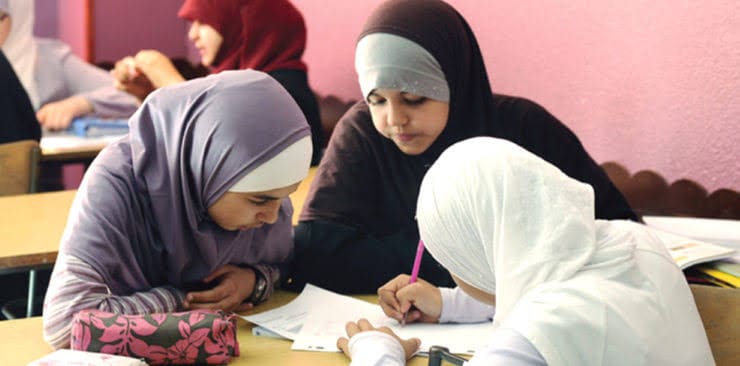
On 13th June 2023, the National Test Agency released the list of the top 50 students who cleared the National Eligibility Entrance Test (NEET). Bareera Ali (18) from Kanpur, Uttar Pradesh, is the only Muslim candidate amongst the top 50. This trend is consistent with the highest of four Muslim candidates in NEET’s top 50 in 2020.
Muslim students have been in the backseat in other national-level exams as well. Out of the 993 candidates who cleared Union Public Service Commission (UPSC) 2022, only 29 were Muslim. In the past seven years, the highest percentage of Muslim candidates qualifying for UPSC was 5.30% in 2019. Despite being the second largest demography in India, this lack of representation of Muslims in the national exams portrays the gap in the Indian education system.
According to the Ministry of Education’s All India Survey on Higher Education Report, 2021, the enrollment of Muslims in higher education institutions is lower than other social groups. With Muslim enrollment at 4.6%, OBCs, SCs and STs represent 35.8%, 14.2%, and 5.8% respectively.
The educational depravity amongst Muslims has repeatedly been reported in various surveys. The Sachar Committee, a seven-member high-level committee appointed by the United Progressive Alliance (UPA) government, chaired by Justice Rajindar Sachar in 2006, studied the socioeconomic and educational status quo of Indian Muslims. The report mentions, “The literacy rate among Muslims in 2001 was 59.1 %. This is far below the national average (65.1 %).”
The report continues to mention that one out of four Muslim children (6-14 age group) have either never attended school or have dropped out. 62% of children in upper-caste Hindu households complete primary education, compared to 44% in Muslims. The Sachar Committee stated that the State has to provide free and compulsory education up to the age of 14, which is also “critical for the improvements in the educational conditions of Muslims.” The committee further suggested setting up an Equal Opportunity Commission and Diversity Index.
The UPA government claimed it had accepted in a print release dated 21 February 2014. “72 recommendations out of the 76 recommendations listed from the Sachar Committee Report.”
A follow-up on the implementation of the Sachar Committee’s recommendations was conducted by the Post-Sachar Committee in 2014. The 10-member panel, headed by Prof Amitabh Kundu, revealed that the condition of Muslims remained unchanged. According to the report, “in 2011-12 (and in 2004-05), other minorities and Hindus were way ahead of Muslims concerning graduation or higher level of education.” Regardless of gender or urban-rural residency variables, Muslims securing secondary, higher secondary level and technical education was lower than Hindus and other socio-religious categories. The Post-Sachar Committee also submitted the report with specific recommendations.
“They (UPA and NDA government) were never serious about implementing the recommendations,” said Prof Kundu. He continued to say that when the committee began their survey, they only had four months before the 2014 General Elections. Eventually, the report had to be submitted to the National Democratic Alliance (NDA), which came to power in 2014. “The NDA government did make some noise and said there will be a parliamentary discussion, but no action was taken,” mentioned Prof Kundu. According to him, mired in political complexities, the recommendations for betterment couldn’t reach the benefactors.
“There has not been adequate campaigning for modern education in Muslims,” said Prof Mujibur Rehman, a political scientist. According to the NSS 75th Round, the Gross Attendance Ratio (GAR) is the lowest for Muslims at all levels of education compared to other religions. GAR is the ratio of students enrolled at each level of education to those in the matching official age group.
Prof Rehman continued to mention that the lack of education in the Muslim demography contributes significantly to the stereotypes circulated about the minority. According to Prof Kundu, Muslims are on the receiving end of the growing communism in India. “There is an element of distrust amongst the population, and the popular narrative is that Muslims are fit for lower paying jobs,” he said.
An Oxfam 2022 report mentioned that discrimination against Muslims in urban areas is less because the work is assigned through agencies, thereby obscuring the religious identity.
Prof Rehman stated, “employers are not looking for diversity in India’s private sectors. Even if they are, Muslims are not on the priority list.” Prof Kundu mentioned that discrimination is less likely in occupations like carpentry, electrical work, etc., where there is little direct physical contact between people.
The Post-Sachar Committee Report states that the 30% of the 5-14-year-olds and 26% among 15 to 24 years olds cite family’s financial constraint as a reason behind school dropout. The overall and constant stigmatization of the Muslim community costs the families employment opportunities which also negatively impacts education, said Prof Rehman. He continued to mention that under the current majoritarian government, any measure taken will be seen as an attempt to appease Muslims.
Ali, who secured AIR 42 in NEET 2023, expressed the weightage of being the only Muslim candidate in the top 50. She believes that the lack of education among Muslims generally leads to misconceptions about Islam. Moreover, she aims to bring about some change possible within her capacity.
Prof Kundu stated that within this context, the Ministry of Minority Affairs should be taking measures to uplift the marginalized community rather than deteriorating the status quo by scrapping minority-centric scholarships like Maulana Azad National Fellowship. “One can conclude that the kind of mega shift that has taken place in the micro-politics of the country has some implications concerning the underrepresentation of Muslims in various sectors and higher education,” said Prof Rehman. The Muslim demography seems to suffer the double-pronged hit of socio-economic underdevelopment and educational depravity, further deteriorated by the ever-rising ostracization and targeted prejudice.
Ainnie Arif is a postgraduate student of Journalism at AJK-MCRC, Jamia Millia Islamia, New Delhi.



